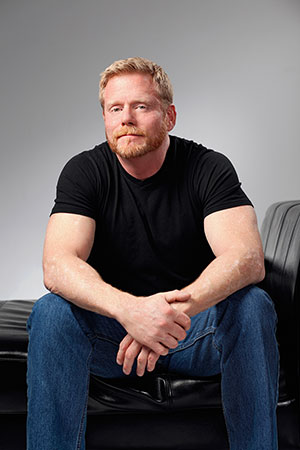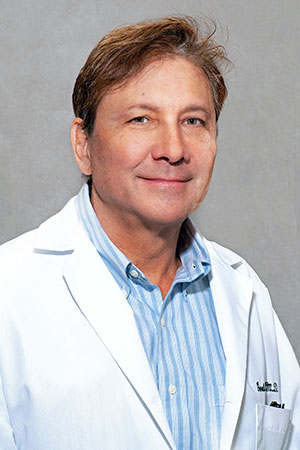The DUAL PRACTITIONER

BY MARY ANN KOENIG
Dr. Gerald Pierone of Vero Beach had a front-row seat to one of history’s most critical epidemics in 1986.
It was the heart of New York City at Mount Sinai Hospital, and Pierone was completing an infectious disease fellowship when the AIDS epidemic exploded. As daily patient counts climbed, Pierone and his colleagues confronted an unprecedented disease with a stark mortality rate and an unrelenting ferocity. Nearly 95 percent of those infected were dead within two years.
“In those days we really didn’t have effective treatment,” Pierone says. “You saw all these young men come in and they would be dead within six months or a year. It was a really, really tragic time.”
Today, Pierone divides his time between two distinct medical disciplines, infectious disease treatment and research, and aesthetic cosmetics. It might seem incongruous that Pierone is both a member of the Infectious Disease Society of America as well as a certified liquid facelift specialist, but his medical proficiencies helped spawn one world out of another. And his therapeutic treatments formed a nexus between the two.
His work with HIV/AIDS patients is now into its fourth decade, indicating a doctor who wouldn’t give up the fight to help arrest a virus and treat its underlying malignant symptoms. Along that journey he learned techniques that would help alleviate a disfiguring side effect from the drugs that kept his patients alive.
Those techniques eventually led to Facial Rejuvenation, his specialty cosmetics practice in Vero Beach where he utilizes lasers, dermal fillers, and other cutting-edge aesthetics treatments to beautify and enhance a youthful appearance.
AZT was the first antiretroviral drug used to combat the AIDS virus. And as part of the AIDS Clinical Trials Group, a National Institutes of Health network study, Pierone and his colleagues at Mount Sinai did the first study to test the efficacy of AZT versus a placebo.
SIDE EFFECTS

Later a combination “cocktail” of drugs, typically three different medications taken in combination multiple times a day, kept the virus in check. The drugs brought the first hope of survival for people with AIDS. But they came at a cost. Physical side effects included an identifying AIDS stigma that was literally written on patients’ faces.
Mark S. King is an AIDS survivor, activist and blogger. Pierone has treated him for a condition known as facial lipoatrophy or facial wasting, an abnormal loss of facial fat. That disfiguration was caused by the early AIDS drugs and had consequences that couldn’t be hidden.
“In the world of HIV/AIDS, it was like the scarlet letter,” says Pierone. “And there was no effective treatment.”
The legacy of the arresting drugs and the side effects would last a lifetime. “As the years progressed,” King recalls, “the lines in our faces grew deeper. We represented something very uncomfortable, this terrible epidemic and mortal crisis.”
Daniel Pearce, diagnosed with AIDS at the age of 39, has been Pierone’s patient since 1994. “I was told I had six months to live,” he says. Under Pierone’s care he began taking a retroviral protease inhibitor called Crixivan, and his immune system stabilized. But Crixivan was part of a “cocktail” along with another drug, d4T, and that ultimately led to facial wasting.
“I felt like with lipoatrophy, it was a lot worse than I ever felt with the disease,” says Pearce. “My eyes were sunken in. My face was like a skeleton with skin stretched over it. I swear I looked like a dead person.”
The toxicities of the drug combinations created not only facial wasting but other physical anomalies. “They produced this weird form of mitochondrial toxicity. People would lose not just facial fat but superficial fat in their arms and elsewhere on their body,” Pierone says.
This fat redistribution is known as lipodystrophy and might improve with a change in medication, but facial wasting was often a permanent physical condition. “Even though patients’ immune systems were coming back, they still looked sick,” says Pierone.
For physicians and patients, physical appearance took a back seat to survival. A compromised immune system would be attacked by a long list of opportunistic diseases such as pneumocystis pneumonia, lymphomas, Kaposi’s sarcoma and cryptococcal infections. These were the true killers. “We really had very few tools,” Pierone says. “And until the immune system could be restored, the battle for survival was against these types of illnesses.”
NEW GENERATION OF DOCTORS

Pierone had gone into infectious disease initially with a high sense of idealism. “I wanted to save the world,” he says. “As a young person, you don’t have the realities of life bearing down on you, so I wanted to go to Africa and be like Albert Schweitzer.” But instead, infectious disease landed on his doorstep.
As a pre-med undergraduate at the University of Florida in a medical honors program, Pierone qualified for a fast track into the university’s medical school. “It was some of the happiest times of my life. Very hard, very intense, but a great, great time in Gainesville,” he says.
During the Mount Sinai fellowship in New York, a division grew among the infectious disease physicians. The older generation of doctors continued working traditionally within the specialty, researching malaria and other known contagions. “They really wanted nothing to do with HIV,” says Pierone. “It was a lot of work, and tragic work too, people were dying.” Consequently, the next generation of young doctors, Pierone and his colleagues, took over the HIV work. “The attendings kind of said, ‘Look we don’t really want to do this, you do it,’ so, as fellows, we became the de facto people in charge of the HIV clinic.”
Their clinic was initially open just one afternoon, every other week, but expanded with the scope of the epidemic, ultimately opening three full days a week. “It completely took over the specialty,” Pierone says.
He spent two more years at Mount Sinai as an assistant professor and infectious disease specialist while his wife, Nancy Cho, completed her cardiology medical training.
In 1990 they decided to move to Vero Beach.
It was a decision driven by the financial reality of living in New York City and carrying student loans from two medical school educations. But it was a difficult decision. Pierone thought he’d be leaving his work with HIV behind. In Vero, however, a new patient population was waiting for him. “When we came here, there really wasn’t anybody working with HIV, and word got out. I became a magnet and started seeing people from Cocoa Beach to just north of Palm Beach.”

He set up an office in downtown Vero, then moved near the hospital. When the Florida Community Health Center in Fort Pierce needed a physician for its growing list of HIV patients, Pierone took a part-time position there, two afternoons a week, while continuing to work as an infectious disease consultant at Indian River Hospital, now Cleveland Clinic Indian River Hospital.
“What I love and admire about Dr. Pierone,” King says, “is that he was the first in my community to step up and say, ‘I want to focus on this.’ He could have said, ‘I have a perfectly good practice in a vacation destination, I don’t have to do this,’ but he did.”
Pierone’s affiliation with Florida Community Health Center grew and changed over the years.
Shortly after he began at the clinic, he teamed with two nurse practitioners: Dorothy Bulgin, already employed at the clinic, and Chandra Kantor, whom he hired. Together they formed the core of the HIV medical staff. Kantor remembers her interview with Pierone. “I said, ‘I don’t know much about HIV/AIDS,’ and Dr. Pierone replied, ‘Don’t worry, I’ll teach you.’”
FEW TRAINED

Daniel Pearce, shown prior to treatment on the left, was the first patient Pierone treated for lipoatrophy. Pearce’s sunken cheeks resulted from a side effect of early HIV/AIDS drugs. The treatments gave Pearce a new look, shown at right.
The clinic would quickly become well known among the gay community and heterosexual HIV/AIDS patients. “There was a high transmission rate of HIV in Fort Pierce,” says Kantor. “It was one or two in the country for heterosexual transmission.”
According to Pierone, “HIV was more a disease of poverty. Our African-American patients were Haitians working in the sugar industry, almost fifty-fifty male to female. And we were seeing the full gamut of HIV, plenty of gay men, but also those who’d gotten HIV through intravenous drug use.”
Bulgin remembers before Pierone started at the clinic. “At that time there was no one really trained in HIV/AIDS work in the area. I heard of Dr. Pierone and I went down to meet him in Vero Beach.”
Then Pierone quickly became a known entity within the AIDS community. “You would hear about Dr. Pierone,” says Kantor. “That he was providing HIV care. So, you couldn’t go to rallies or meetings without hearing his name.”
Kantor recalls the early days. “It was hard. Every day or other day, people were dying. And some families rejected them because they were gay or because of the stigma of the disease.”
The new HIV drugs would begin to make a difference for some and take a toll for others. “At the time AZT did more damage than good to some patients,” Bulgin says. “Some decided not to take it because it made them so sick. I attended quite a lot of funerals.”
In 1995, new administrators at Florida Community Health Center decided to break up the clinic and distribute HIV patients among the primary care providers. Pierone, Bulgin, and Kantor thought it was the exact wrong thing to do.
As new medications became available, HIV morphed into a specialty disease where knowledge of those medications was critical, and dosing was complicated. Pierone, Kantor, and Bulgin decided to leave the health center and open a new medical facility, AIDS Research and Treatment Center of the Treasure Coast, a non-profit clinic that survived and thrived despite financial hurdles. “We ran the HIV clinic on kind of a shoestring,” says Pierone. But the clinic’s vital AIDS research and drug trials became a significant frontline defense for patients affected with the disease. “We struggled financially, but we never gave up. It was like living paycheck to paycheck,” says Bulgin.
To help establish the new clinic and raise funds, Pierone went out into the community and enlisted board members. Citrus pioneer George Hamner was among the first on the ARTCTC board. Vero resident Burton Lee had been appointed by President Ronald Reagan to the President’s Commission on the HIV Epidemic and was later White House physician to President George H.W. Bush. Their involvement helped ensure success.
Meanwhile, the FDA and drug companies began an unprecedented drive to find new medicines to slow the virus’s catastrophic toll. They started listening to and working with AIDS activists and doctors, slashing the normal five-to-seven years “trial to market” times for drug approval because of AIDS.
In 1994 a faint shimmer in the world of AIDs turned into light at the end of the tunnel. Triple therapy drugs were developed. “We were able to get viral levels to undetectable,” says Pierone. “And that would lead to immune systems rebuilding. The disease transformed from universally fatal to a controllable disease.”
At the height of the epidemic, Pierone was the director of a 12-bed, HIV unit at Indian River Hospital. In 1994 the average census was 13.4 patients. “And literally within two months of these medications becoming approved, our census dropped to two or three, and we closed the unit. It was that dramatic,” he says.
APPROACH CHANGES

Of the 15,527 reported AIDS cases in the U.S. in 1985, 12,529 resulted in deaths, an 81 percent death rate. By 1996 the dramatic rate of infection had climbed to 581,429, but the death rate had dropped to about 62 percent, according to amfAR, the Foundation for AIDS Research.
King remembers the early days of those life-saving drug treatments and their side effects. “Issues of vanity got pushed aside for issues of mortality.” Later, that thinking changed. “We thought to ourselves, ‘If I’m going to live for another twenty years, I’d like to fix my face.’ We still have many long-term survivors who bear those physical side effects,” King says.
Around 2003 word spread through the gay community of a dermal filler available in France that could restore shrunken facial features. It was known as New-Fill. “If people had money, they were flying to Paris and getting treated for HIV facial wasting,” says Pierone.
A Miami doctor, Peter Engelhard, went to Paris to learn the injection techniques. He returned to his practice and treated patients who would bring in their own New-Fill product that they had acquired through “buyers clubs” cropping up in the U.S. “I learned about him,” says Pierone, “and I sent my patients to him.”
In August 2004 the FDA approved the new poly-L-lactic acid dermal filler, by then known as Sculptra, for use in treating facial wasting. The treatments required several injections over periods of weeks and months. Pierone and his patients were looking for a solution closer to home to avoid the travel to Miami. But local plastic surgeons and dermatologists were not prepared to endure, as Pierone refers to it, “the pretty onerous paperwork” that the FDA attached to Sculptra as a remedy for lipoatrophy.
Pierone then asked Engelhard to teach him the technique so he could treat his patients in Vero and Fort Pierce. “I told my wife, I’m going to Miami to learn how to inject Sculptra, and she said, ‘Gerry, you don’t even put the cap on the toothpaste, how in the world are you going to inject people’s faces?’”
Daniel Pearce was his first guinea pig. Engelhard and Pierone shared the injection responsibilities. “He injected half the face,” says Pierone, “showed me how to do it, and I injected the other half.”
Pearce’s results were dramatic. “The first time I thought, ‘This is wonderful,’ my face was back to normal,” says Pearce. But those effects would require subsequent injections to sustain facial fullness. “I didn’t feel like I was a dead skeleton anymore. I had a face again, I had cheeks, bones, and a jaw.”
By then Engelhard had experience with the injection process and also with patients’ reactions. Pierone was unprepared for what happened next. He heard Engelhard say to a patient, “I’m going to give you the mirror now, it’s OK to cry.” Pierone remembers being confused by the comment. “But, as if on cue, the patient looked in the mirror and broke into tears. And I thought this is not a trivial thing, this is a real big deal for people,” Pierone says.
The results for King were just as dramatic. “It’s not about erasing part of my identity. I’m proud of my identity and that includes living with HIV, but I also just want to be Mark. Dr. Pierone has allowed me to just be Mark again, and not Mark, that guy who looks like he has AIDS.”
Even though Sculptra was FDA approved only for lipoatrophy, many physicians began using it “off-label” as an aesthetics facial filler. Subsequently, Pierone began to get requests from his family and friends. “’What about treating me?’” Pierone remembers them asking.
“’I’m getting older, my face is getting thin.’” Thus, the genesis of Pierone’s Facial Rejuvenation practice that thrives in Vero today. “I’m thrilled for him,” says King. “It just turns out that this compassionate HIV physician had a remarkable talent for doing this, and doing it cosmetically. More power to him.”
CLIENTS INVOLVED
The Aids Research and Treatment Center of the Treasure Coast has changed over the years and grown. Through creative partnerships with available federally-funded pharmacy and treatment programs, there are now two clinics, one in Fort Pierce and another in Vero. Pierone and his board created these fully-staffed, non-profit federally qualified health clinics, now called Whole Family Health Center.
Their newly-built administration building is nearly complete, and they’ve recently hired four new physicians, a pediatrician and three family practice doctors, as well as several specialty nurse practitioners. The facilities have a fully-staffed call center to field questions and a new van, provided by a John’s Island Foundation grant, to transport patients to the clinics.
One of the requirements for a federally qualified health center is that 50 percent of the board members must be clients. Pearce is on the board. “It’s useful,” says Pierone. “They want representation.” Pearce says, “I’m proud to be part of the board and to help make decisions to move things forward.”
Pierone still sees patients three days a week in the Fort Pierce and Vero clinics. Some are his long-term HIV patients and others are infectious diseases patients, such as those with Hepatitis C. “We’ve come full circle with HIV,” he says. “It’s become a primary care disease. Why? Because the meds are so much more potent, more effective, and many fewer side effects. It’s pretty straight forward now, almost like treating diabetes.”
He also still treats patients for facial wasting, but very few. The numbers with lipoatrophy dwindled, as the side effects caused by early HIV drugs mostly disappeared. A single daily pill can keep the virus in check without causing facial wasting.
Pierone’s transition into an aesthetics physician had its roots in treating those HIV patients and witnessing their reaction to a restored face gazing back at them in a mirror.
“Over the years I’ve seen that drama play out many, many times,” Pierone says. “It’s definitely one of the most rewarding things I do to this day.”
